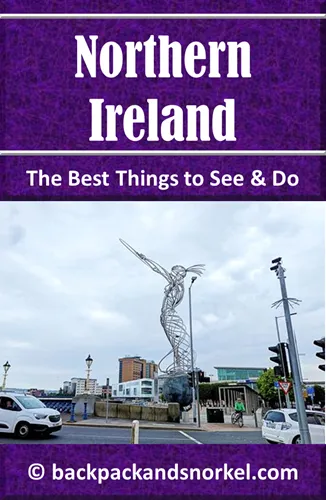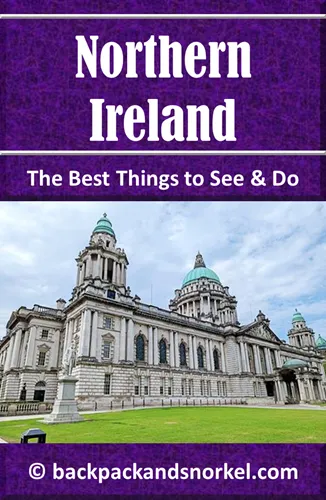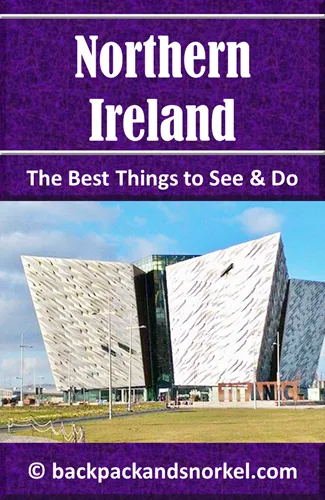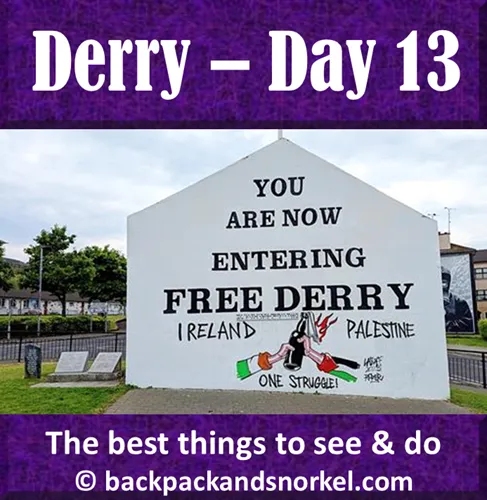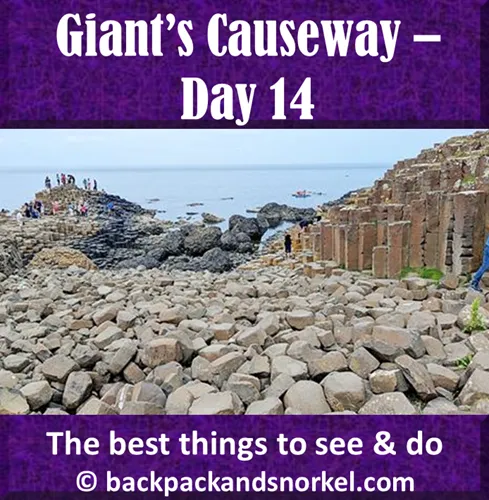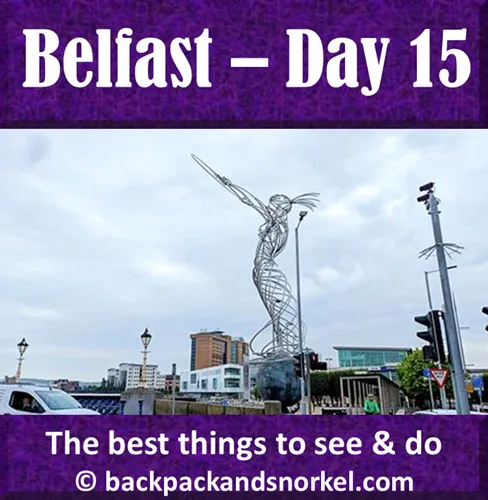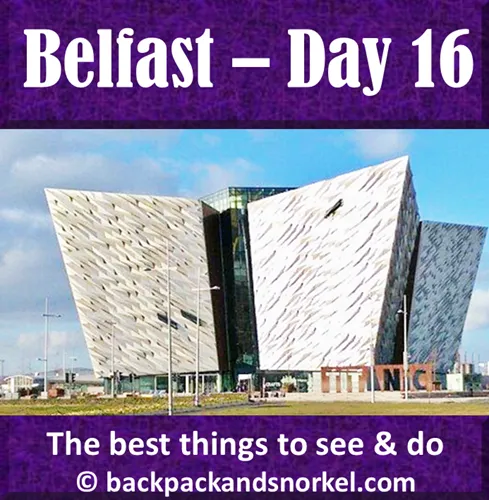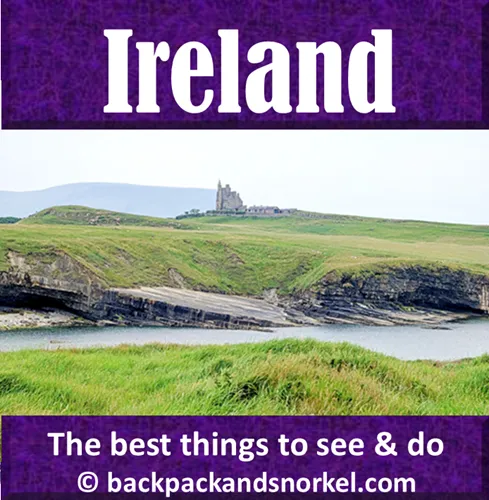Backpack and Snorkel Travel Guide for a Self-Guided City and Murals Tour of Belfast - Northern Ireland Purple Travel Guide
Belfast is a fascinating city. Today we will explore the downtown area on a Self-Guided City and Murals Tour of Belfast. We provide detailed information and the best things to see and we show lots of photos so you know what you can expect.
Today we will do a lot of walking. Our self-guided Belfast walking tour will consist of 3 parts:
- Part 1: Three sights including the wonderful Belfast City Hall museum
- art 2: Murals walking tour
- Part 3: Eight more destinations and the wonderful Victoria Square shopping mall
Part 1: self-guided Belfast city tour

A = Grand Opera House
B = Belfast City Hall
C = Corn Market
Part 2: Belfast murals tour

C = Corn Market
1 = Street Art Walk – Bridge St and North St
2 = Street Art Walk – Royal Ave, Kent St, Union St, Library St
D = Belfast Central Library
Part 3: self-guided Belfast city tour

D = Belfast Central Library
E = St Anne’s Cathedral
F = Merchant Hotel
G = Albert Memorial Clock
H = The Big Fish
I = Nuala with the Hula / Beacon of Hope
J = Victoria Square Shopping Centre
K = Old Town Hall
L = St George's Market
Here at Backpack and Snorkel Travel Guides, we typically promote self-guided walking tours.
But we realize that not everybody likes to walk by themselves in a foreign city. So, just in case that you rather go with ab guide: NO PROBLEM! Please see the free GuruWalk and paid Viator tours below.
free GuruWalk tours
paid Viator tours
Table of contents
Grand Opera House
The Grand Opera House is the only Victorian theater in Northern Ireland. It opened its doors 1895 under the name New Grand Opera House and Cirque. It was renamed to Palace of Varieties in 1904, and again in 1909 to Grand Opera House. In 1908, Charlie Chaplin performed here.
The British Theatres Trust said: the ‘magnificent auditorium is probably the best surviving example in the United Kingdom of the oriental style applied to theatre architecture’.
From 2020 – 2021, the auditorium was restored to its former appearance, and the foyer spaces and bars were reimagined to what they are today.
If you don’t attend a show, then you can either marvel at its unique façade, or attend one of the very few guided tours that are offered per year.
At the time of writing, admission to the tour is £12.50 per adult and a tour lasts 45 – 60min.


Belfast City Hall
In 1888, Belfast was awarded the status of a city by Queen Victoria. A new city hall building that better represented the city’s status was constructed from 1898 – 1906 to replace the Old Town Hall on Victoria Street. After the building was finished, construction of an almost exact replica started in Durban, South Africa.
The interior is partially open to the public. Visitors can see the Grand Entrance, the Grand Staircase, several beautiful stained-glass windows, and the Visitor exhibition (museum).
At the time of writing, the opening hours are:
Mon to Fri 9.30am to 5pm with last admission at 4pm
Sat – Sun and bank holidays 10am to 5pm with last admission at 4pm
Admission is free.
The Visitor exhibition is located on the ground floor in the east wing. It offers a self-guided journey from Belfast’s past to present, showing the vibrancy and diversity of the city across six themed zones. The six themes are:
- The City, Growth and Governance
Three rooms explore the development of Belfast from its foundation in 1613 to the construction of City Hall. - The City at Work and Play
Three rooms explore the industrial heritage of Belfast from its most famous ship Titanic to Belfast’s famous music venues and theaters. - City Speech and City Streets
Three rooms explore the rich heritage behinds Belfast’s unique words and phrases, an opportunity to interact with the Belfast street directory of 1897 and a room exploring the games played by the children in Belfast’s streets. - The City Commemorates
Four rooms exploring the religious and political divisions of Belfast examining how they have both shaped and been shaped by history locally, nationally, and internationally. - The Reflection Space
Visitors can read archived experiences of Belfast’s citizens recorded during the traumatic years of ‘The Troubles’ and to pause and reflect on this painful period in the City’s recent past. - The City Celebrates
Two rooms which celebrate the famous sons and daughters of Belfast who have put Belfast on the map for their incredibly diverse achievements in the worlds of Science, Technology, Sport, Literature, Music, Art, etc.
Outside of the city hall are large amounts of memorials, including the Titanic Memorial Gardens with a list of all 1,512 victims, and the Cenotaph which was built in memory of all those who died in the WWI.
The memorials are:
- Cenotaph
Belfast War Memorial - a memorial to those who are buried elsewhere, built from 1925 to 1927 and unveiled on Armistice Day 11 November 1929 - Courtyard fountain and trees
Dedicated to all the council employees who were killed or injured at work from 1969 until 1999 during ‘the troubles’. The water of the fountain and trees planted in the courtyard represent hope, rebirth, and a new beginning for Belfast. - Eliza Ward Plaque
At the age of 18, Eliza gave her life in protection of her employer near this spot in July 1997. Her selfless act of bravery resulted in the posthumous award of the George Cross by HM Queen Elizabeth II; a rare honor for a civilian to receive. - Korean War Memorial
Originally erected and dedicated in Chaegunghyon, Korea to commemorate men who fell during a tough defensive action in the mountains north of Seoul in January 1951. It was erected originally on the battlefield, but in 1952 was transported to Northern Ireland on the HMS Belfast and re-erected at St Patrick’s Barracks in Ballymena. The memorial was rededicated at City Hall in 2010. - Lord Dufferin Memorial
Sculpted by the architect of City Hall, this memorial was unveiled in 1906. Frederick Temple the Marquess of Dufferin and Ava through a number of diplomatic roles worked in India, Canada, Russia, Turkey, Rome, and Paris. The sculpture shows the Marquess depicted in the robes of the Order of St Patrick below a canopy surmounted by the winged figure of Fame. Accompanying figures represent Canada and India - Mary Ann McCracken and Winifred Carney statues
McCracken was an abolitionist, social reformer, and activist who fought for the rights of women and championed Belfast’s poor, while Carney was a suffragist, trade unionist, and Irish independence activist. - Operation Banner Memorial
This small sculptural bench was placed here in memory to the servicemen and women of Operation Banner (1969 - 2007). Operation Banner was the operational name for the British Armed Forces' operation in Northern Ireland from August 1969 to July 2007. It was the longest continuous deployment in the British military's history. - Pirrie Memorial
William Pirrie, served as Lord Mayor of Belfast between 1896 and 1898. He was instrumental in the conception of Titanic but also in the idea of a new civic building for Belfast in City Hall. - Queen Victoria
Created to celebrate the Diamond Jubilee of Queen Victoria in 1897, it was unveiled by her son, King Edward VII in 1903. Carved from Sicilian marble and standing 11 feet high, this memorial is accompanied on each side by life size bronze figures representing spinning and shipbuilding. The reading child to the rear of the sculpture represents education. - R J McMordie
Carrara marble statue of the Lord Mayor of Belfast from 1910-1914. - Royal Irish Rifles Memorial
A bronze figure of a private of the regiment. Memorial to the officers and men who died in the South African War (1899-1902). - Seaman Magennis VC Memorial
Commemorates the awarding of the Victoria Cross to Leading Seaman Magennis, for outstanding bravery in World War II – he was crucial in her attack of the Japanese cruiser Takao on 31 July 1945. - Sir Daniel Dixon
Lord Mayor of Belfast in 1892-1893, 1901-1903 and 1905-1906. - Sir Edward Harland
Mayor of Belfast from 1885 until 1886 - Sir James Haslett
Mayor of Belfast from 1887-1888 - Titanic Monument
White Carrera marble monument. The female figure of Death or Fate looks down at two sea nymphs rising from the waves, with the body of a drowned sailor in their arms. It was thought at the time that only 22 local people had died in the disaster and only the names of those victims are recorded on the original memorial. - Titanic Memorial Garden and Plaques
Officially opened on 15 April 2012 to commemorate the 100th anniversary of the sinking of RMS Titanic. The upper level displays bronze plaques listing all 1,512 victims of the disaster in alphabetical order - passengers and crew. It’s the first memorial anywhere in the world to record the names of all the victims who died on one monument. - USA Expeditionary Force Memorial
Unveiled in 1943 this column was originally situated at the gateway of City Hall but was moved to its current location and was rededicated in 1995 by American President Bill Clinton. The monument marks the landing of the first American troops in Europe during the Second World War. It bears the badges of the United States Army, Marine Corps and Navy. - 9/11 Memorial plaque and tree
Unveiled on 11 September 2002, the first anniversary of the tragic events, to commemorate all those who lost their lives in the terrorist attacks in New York, Washington DC, and Pennsylvania on 11 September 2001.




Spirit of Belfast on Arthur Square (Corn Market)
The plaza is named after Sir Arthur Chichester (1563-1625), who was one of the most ruthless English commanders in Ireland during the Nine Years' War. He is also considered the founding father of Belfast, because he offered to rebuild Belfast Castle, which was in ruins after the Nine Years' War, if he was granted Belfast and its surrounding lands by the Crown. In 1603, the King obliged and Chichester made it a successful Plantation attracting mainly English and Manx (Isle of Man) settlers.
Arthur Square is sometimes called Corn Market, after the Corn Market street that merges into it from the northwest.
The Spirit of Belfast is a steel sculpture that was unveiled in 2009 and, as people in Northern Ireland like to do, it has been given a nickname: the Onion Rings.
The colored lighting is designed to reflect the texture and lightness of linen, while the metal reflects the strength and beauty of shipbuilding, two important aspects of Belfast's history.
The Spirit of Belfast was chosen by the public out of three designs that were chosen by a committee that held the Arthur Square Artwork competition.


Street Art Walk – Bridge St and North St
From Arthur Square, walk north east for 280 ft (85 m) on High St and then turn left on Bridge Street.
Enjoy the murals on Bridge St and continue walking north even when the street name changes to North St after 310 ft (95 m).
North Street has lots of murals, make sure to also check out the side streets, where there are more.
Walk on North St for a total of 1,300 ft (400 m) until just after Winetavern St and enjoy the many murals.




Street Art Walk – Royal Ave, Kent St, Union St, Library St
Now walk back to the intersection of North St with Royal Ave and turn left on Royal Ave where you will see more murals.
From Royal Ave take the first left on Kent St for more murals, then the first right on Union St and then another right onto Library St. There are murals on all these streets and some side streets.
End your murals tour Belfast Central Library.





Belfast Central Library
Opened in 1888, Belfast Central Library was one of the first major public library buildings in Ireland.
It is an impressive Victorian era building with a black granite base, and a red sandstone exterior with some Italian influences. The interior has a sweeping staircase, a pillared foyer, and a domed 1st floor reading room.
Displayed in glass cases in the reading room are some maps from the early 1800s.
If you have 15min, a visit of the library is definitely worth it.
At the time of writing, opening times are:
Mon & Thu: 9am – 8pm
Tue, Wed & Fri: 9am – 5:30pm
Sat: 9am – 4:30pm
Sun: closed




St Anne’s Cathedral
Construction of St Anne's Cathedral, or in short: Belfast Cathedral, was started in 1899 and it was consecrated in 1904. Several additions were made throughout the 1920s and the late 20th century. In 1941, a German bomb spared the cathedral, but caused extensive damage to nearby properties.
A 131 ft (40 m) stainless steel spire was installed on top of the cathedral through a glass platform in the cathedral's roof in 2007. It is called the ‘Spire of Hope’, and is illuminated at night
Unlike most Cathedrals, there is only one Tomb in the Cathedral – that of Lord Carson of Duncairn. Lord Carson was an Irish Unionist politician, barrister, and judge.
The 1,517 lives lost in the tragic sinking of the Titanic, which was built in Belfast are commemorated in a hand-crafted funeral pall which was dedicated in St Anne’s Cathedral a century after the disaster. The pall was made of pure Merino felt, and it is backed with Irish linen and dyed in indigo blue, evoking an image of the midnight sea in which the Titanic finally came to rest.
The Regimental Chapel, consecrated on the anniversary of D-Day in 1981, contains many important historical artefacts including Books of Remembrance, the font, lectern, and chairs presented by families in remembrance of soldiers who had lost their lives.
The mosaic roof of the Baptistery is of exceptional interest, being a magnificent example of art adapted to the Romanesque style of architecture. Its emphasis is on space, both on the walls and domed roof.
Coventry Cross Of Nails: St Anne’s Cathedral was spared destruction from German bombers during the Belfast Blitz in 1941. The morning after the bombing, a priest walked through the rubble of Coventry Cathedral in the West Midlands that was destroyed by German bombers in 1940. He found several large, medieval carpenter nails from the collapsed roof, and bound three with some wire together in the shape of a cross. Later he got the nails welded and plated to create the first Cross of Nails, symbolizing both suffering and the hope of survival.
More than 100 additional crosses were made from nails salvaged from the rubble over the next several years. They were given as symbols of peace and reconciliation to other cathedrals and churches and also to prisons and schools.
In 1976, the Dean of Belfast started his annual Christmas 'Sit Out', where he was sitting on the steps of the cathedral during the daytime hours of the week before Christmas, accepting donations from people that passed by. He then distributed the money between local charities. Because of his dark clothes that kept him warm, he was soon called the ‘Black Santa’.
This tradition is still observed by the Dean and members of the cathedral chapter who are still collectively called the 'Black Santa'.
At the time of writing, opening hours for tourists are:
Mon – Sat: 10:30am - 4pm with last admission at 3:15pm
Sun: 12:30pm - 3.30pm; 11am Choral Eucharist & 3.30pm Choral Evensong or Evening Prayer
Admission is £3 for a self-guided tour, £1 for a guidebook, or £7 for an accompanied tour (Audio Guide or Cathedral Steward).




On your way to the next destination, the Merchant Hotel, make sure to explore Exchange Pl.


Merchant Hotel
Built in the mid-19th century as the headquarters of the Ulster Bank, the building was converted into the five-star Merchant Hotel in 2006.
The chandelier for The Great Room Restaurant is made from embellished gold on metal and 2,600 crystal pieces in 2006.
It is 15 ft (4.5 m) tall, 10 ft (2.9 m) in diameter and weights 882 lbs (400 kg). That makes it the largest chandelier in Northern Ireland and Ireland.


Albert Memorial Clock
The Albert Memorial Clock, commonly referred to as the Albert Clock, is located in Queen's Square and is one of the best-known landmarks of Belfast. It was built from 1865 – 1869 on wooden piles on marshy, reclaimed land around the River Farset. Due to ground settlement, the top of the tower leans by 4 ft.
To stop the clock tower from leaning even more and eventually collapsing, and to repair surface damage, the tower and its foundation were repaired in 2002 in a multimillion-pound restoration project.

The Big Fish
The Big Fish is a 33 ft (10 m) long statue that was built in 1999 and has a cladding of ceramic tiles decorated with texts and images relating to the history of Belfast as its outer skin.
The Big Fish contains a time capsule with information, images, and poetry of Belfast.
The statue is also known as Pat The Fish, apparently because visitors from Orkney, Scotland patted the fish for good luck.


If you look across the street, you will see the beautiful façade of the Custom House, which is closed to the public.


Nuala with the Hula / Beacon of Hope
The Beacon of Hope was built out of stainless steel, and cast bronze in 2007 and is 64 ft (19.5 m) tall.
It is located in Thanksgiving Square and is thus also called Thanksgiving Square Beacon.
Since Northern Irelanders like to give their statues nicknames, it is often called Nuala with the Hula, and sometimes also the Belle on the Ball, the Thing with the Ring, Our Lady of Thanksgiving, or the Angel of Thanksgiving.
Recognized as the best artwork in the city by the Belfast Chamber of Trade and Commerce, the statue was adopted as an emblem and logo by tourism authorities, TV stations, many businesses and even the Belfast City Council. This has made Nuala with the Hula one of the most recognized statues in Belfast.
The bottom is a globe that communicates the universal philosophy of peace, harmony, and Thanksgiving. Inscribed on its surface are the cities to which the people and industries of Belfast have migrated and exported to.
From the top of the globe, spiraling upwards, are the outlines of a woman holding ‘the ring of Thanksgiving’.




Victoria Square Shopping Centre
Opened in 2008, Victoria Square is a 4-story 800,000 square feet (74,000 m2) shopping mall and residential complex with 62 stores, 16 restaurants, and movie theater.
The centerpiece that makes it special is a huge glass dome, which is 121 ft (37 m) in diameter and 148 ft (45 m) tall. It covers a public courtyard with central access to an elevator and escalators to all floors.
In front of the mall stands the Jaffe Fountain, which was constructed in the 1870s by former Lord Mayor Otto Jaffe in memory of his father.




Old Town Hall
The Town Hall was built in 1871 in Italianate style, using red bricks with red sandstone dressings.
After Belfast was awarded city status by Queen Victoria in 1888, leaders wanted a more impressive building and decided to build the new Belfast City Hall.
The Old Town Hall has had many different uses over the years, including the home of the newly formed Ulster Unionist Council, barracks of the Ulster Volunteer Force, recruitment office of the Ulster Volunteer Force, and a courthouse.
At the time of writing, the building is vacant.

St George's Market
St George's Market is the last surviving Victorian covered market in Belfast.
On this site from 1604 until 1890, was an open market and most likely contained a slaughterhouse, and a meat market.
The covered St George's Market, which encompasses an area larger than the original uncovered market, was built from 1890 – 1896 out of red bricks with sandstone dressing and features Roman styled arches.
Today St George's Market is home to 200 market stalls selling fruit, vegetables, antiques, books, clothes, hot food, cakes and buns, crafts and a large selection of fresh fish.
It was voted Best Large Indoor Market in 2014 and 2023, and in 2006, the National Association of British Market Authorities named it one of the UK's top five markets.
At the time of writing, St George's Market is open:
Fri: 8am to 2pm
Sat: 9am to 3pm
Sun: 10am to 3pm

Where do you want to go now?
Other popular Purple Travel Guides you may be interested in:
Like this Backpack and Snorkel Purple Travel Guide? Pin these for later:


